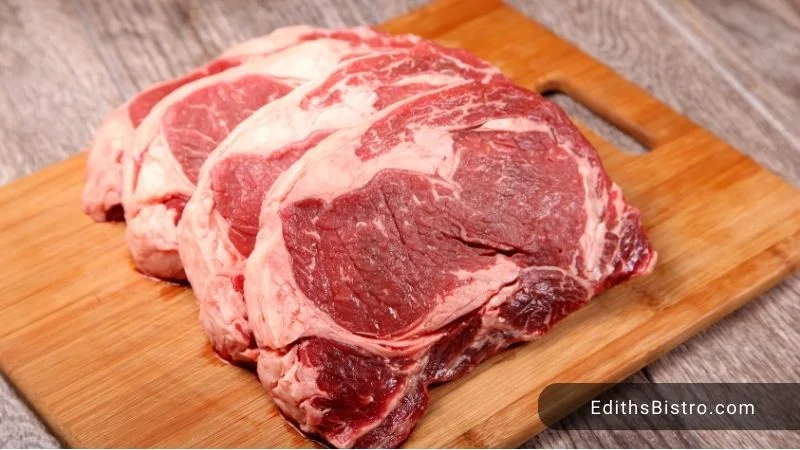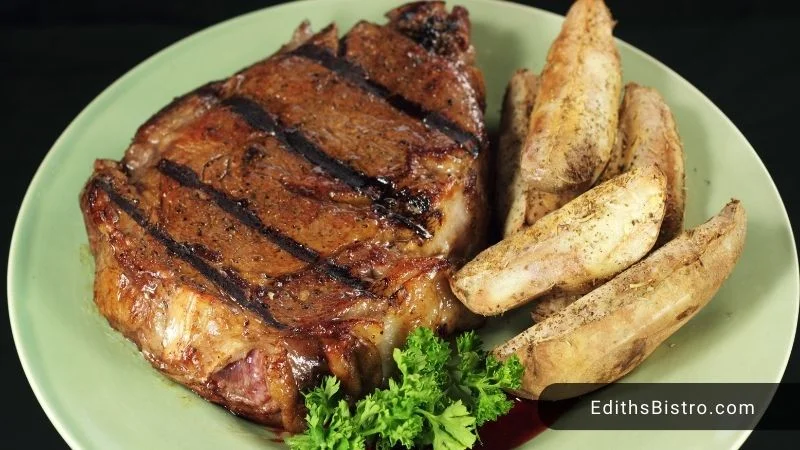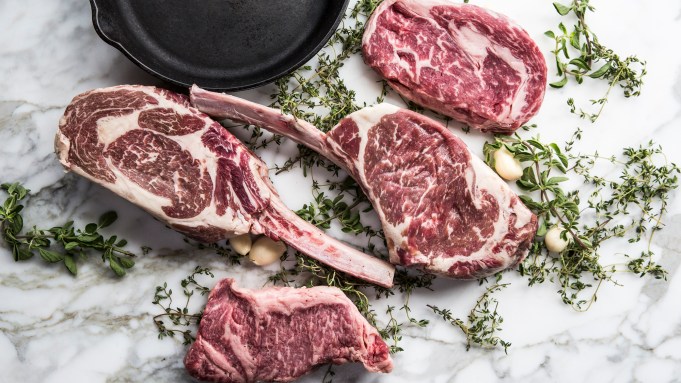
Introduction
When it comes to choosing a steak cut, two popular options that often come to mind are Delmonico and Ribeye. While both cuts are known for their exceptional flavor and tenderness, there are distinct differences between the two. In this blog post, we will explore the variations between Delmonico and Ribeye, and discuss the factors to consider when choosing the right steak cut for your preferences.
Delmonico Vs Ribeye: Understanding The Differences
Delmonico steak, also known as a boneless ribeye or ribeye cap, is a cut taken from the rib section of the cow. It is known for its marbling and tenderness, making it a favorite amongst steak enthusiasts. The rich marbling in Delmonico steak gives it a melt-in-your-mouth texture and enhances its flavor profile. This cut usually has a higher price point due to its exceptional quality and desirable characteristics.
On the other hand, Ribeye steak is cut from the same portion of the cow as Delmonico steak – the rib section. However, Ribeye includes the bone, which adds extra flavor to the meat. Known for its juiciness and robust beefy flavor, Ribeye steak is a popular choice among steak lovers. It has a slightly coarser texture compared to Delmonico, which is due to the presence of the bone.
Factors To Consider When Choosing The Right Steak Cut
When choosing between Delmonico and Ribeye steak, there are a few factors to consider:
- Flavor: Delmonico steak is known for its tenderness and melt-in-your-mouth texture, while Ribeye offers a more robust and beefy flavor due to the presence of the bone.
- Texture: Delmonico steak has a smoother and more tender texture, while Ribeye has a slightly coarser texture because of the bone.
- Price: Delmonico steak is often priced higher than Ribeye due to its exceptional quality and tenderness.
- Cooking Method: Both cuts can be cooked using various methods, such as grilling, broiling, or pan-frying. However, the bone in Ribeye can affect cooking times and techniques.
In conclusion, Delmonico and Ribeye are both excellent steak cuts, each with its own unique characteristics. Consider your preferences for tenderness, flavor, texture, and budget when choosing the right steak cut for your next cookout or steak dinner.
Delmonico Steak
Delmonico Steak: Definition And Origin
Delmonico steak, also known as a boneless ribeye or ribeye cap, is a cut taken from the rib section of the cow. It is believed to have originated from the famous Delmonico’s Restaurant in New York City in the mid-19th century. Delmonico steak quickly gained popularity for its marbling and tenderness, making it a favorite amongst steak enthusiasts.
Flavor And Texture Profile Of Delmonico Steak
Delmonico steak is known for its exceptional flavor and melt-in-your-mouth texture. The rich marbling throughout the meat adds a luxurious taste and amplifies the beefy flavor. This cut is particularly tender and has a smooth texture, making it a pleasure to eat.
Compared to other steak cuts, Delmonico steak offers a more delicate and refined flavor profile. The marbling not only enhances the taste but also ensures a juicy and moist steak when cooked properly. It is important to note that the thickness of the steak can affect the cooking time and temperature to achieve the desired level of doneness.
When it comes to cooking Delmonico steak, it is best to use high heat methods such as grilling, broiling, or pan-frying. These cooking methods help to sear the outside of the steak and lock in the juices, resulting in a flavorful and tender meat.
In terms of price, Delmonico steak is often priced higher than Ribeye due to its exceptional quality, tenderness, and popularity among steak lovers. It is considered a premium cut that is well worth the investment for those seeking a top-notch dining experience.
In summary, Delmonico steak is a boneless ribeye cut that offers exceptional flavor, tenderness, and a melt-in-your-mouth texture. Its rich marbling and delicate taste make it a top choice for steak aficionados. Whether grilled, broiled, or pan-fried, Delmonico steak is sure to elevate any steak dinner or cookout.

Ribeye Steak
Ribeye Steak: Definition And Origin
Ribeye steak, also known as Delmonico steak or boneless ribeye cap, is a cut taken from the rib section of the cow. It is believed to have originated from the famous Delmonico’s Restaurant in New York City during the mid-19th century. Ribeye steak quickly gained popularity due to its marbling and tenderness, making it a favorite among steak enthusiasts.
Flavor And Texture Profile Of Ribeye Steak
Ribeye steak is renowned for its exceptional flavor and melt-in-your-mouth texture. The generous marbling throughout the meat enhances its richness and intensifies the beefy taste. This cut is particularly tender and boasts a smooth texture, providing a delightful eating experience.
Compared to other steak cuts, ribeye steak offers a more robust and distinct flavor profile. The marbling not only improves the taste but also ensures a juicy and moist steak when cooked properly. It is important to note that the thickness of the steak can affect the cooking time and temperature necessary to achieve the desired level of doneness.
When cooking ribeye steak, high heat methods such as grilling, broiling, or pan-frying are recommended. These cooking techniques allow for searing the outside of the steak, sealing in the flavorful juices and resulting in a tender and delicious meat.
In terms of pricing, ribeye steak is often priced higher than other cuts due to its exceptional quality, tenderness, and popularity among steak lovers. It is considered a premium cut that is well worth the investment for those seeking an exquisite dining experience.
In summary, ribeye steak, also known as Delmonico steak, is a boneless ribeye cut that offers exceptional flavor, tenderness, and a melt-in-your-mouth texture. With its abundant marbling and bold taste, it remains a top choice for steak aficionados. Whether grilled, broiled, or pan-fried, ribeye steak is sure to elevate any steak dinner or cookout.
Delmonico Steak Characteristics
Marbling And Tenderness Of Delmonico Steak
Delmonico steak, also known as ribeye steak or boneless ribeye cap, is a highly sought-after cut due to its exceptional marbling and tenderness. This cut is taken from the rib section of the cow and is believed to have originated from the renowned Delmonico’s Restaurant in New York City during the mid-19th century. The generous marbling throughout the meat enhances its richness and intensifies the beefy taste. Additionally, the marbling ensures that the steak remains juicy and moist when cooked properly. The tenderness of Delmonico steak allows it to melt in your mouth, providing a delightful eating experience.
Cooking Techniques For Delmonico Steak
To fully appreciate the exceptional flavor and tenderness of Delmonico steak, it is recommended to use high heat cooking methods such as grilling, broiling, or pan-frying. These techniques allow for searing the outside of the steak quickly, which helps to seal in the flavorful juices. It is important to note that the thickness of the steak can affect the cooking time and temperature necessary to achieve the desired level of doneness. For the best results, it is recommended to cook the steak to medium-rare or medium, as this allows the marbling to melt and infuse the meat with its rich flavor.
When cooking Delmonico steak, it is essential to let it rest for a few minutes after cooking to allow the juices to redistribute and ensure optimal tenderness. This brief resting period will result in a more succulent and flavorful steak.
In terms of pricing, Delmonico steak is considered a premium cut, often priced higher than other steak cuts due to its exceptional quality, tenderness, and popularity among steak lovers. It remains a top choice for those seeking an exquisite dining experience and is well worth the investment.
In summary, Delmonico steak, also known as ribeye steak or boneless ribeye cap, offers exceptional marbling, tenderness, and a melt-in-your-mouth texture. Its bold flavor and smooth texture make it a favorite among steak enthusiasts. Whether grilled, broiled, or pan-fried, Delmonico steak is sure to elevate any steak dinner or cookout.
Ribeye Steak Characteristics
Marbling And Tenderness Of Ribeye Steak
Ribeye steak, also known as Delmonico steak or boneless ribeye cap, is a highly sought-after cut due to its exceptional marbling and tenderness. It is taken from the rib section of the cow and is believed to have originated from the renowned Delmonico’s Restaurant in New York City during the mid-19th century. The generous marbling throughout the meat enhances its richness and intensifies the beefy taste. Additionally, the marbling ensures that the steak remains juicy and moist when cooked properly. The tenderness of ribeye steak allows it to melt in the mouth, providing a delightful eating experience.
Cooking Techniques For Ribeye Steak
To fully appreciate the exceptional flavor and tenderness of ribeye steak, it is recommended to use high heat cooking methods such as grilling, broiling, or pan-frying. These techniques allow for searing the outside of the steak quickly, which helps to seal in the flavorful juices. The thickness of the steak can affect the cooking time and temperature necessary to achieve the desired level of doneness. For the best results, it is recommended to cook the steak to medium-rare or medium, as this allows the marbling to melt and infuse the meat with its rich flavor.
When cooking ribeye steak, it is essential to let it rest for a few minutes after cooking to allow the juices to redistribute and ensure optimal tenderness. This brief resting period will result in a more succulent and flavorful steak.
Ribeye steak is considered a premium cut and often priced higher than other steak cuts due to its exceptional quality, tenderness, and popularity among steak lovers. It remains a top choice for those seeking an exquisite dining experience and is well worth the investment.
In summary, ribeye steak offers exceptional marbling, tenderness, and a melt-in-your-mouth texture. Its bold flavor and smooth texture make it a favorite among steak enthusiasts. Whether grilled, broiled, or pan-fried, ribeye steak is sure to elevate any steak dinner or cookout.

Comparing Delmonico And Ribeye Steaks
Difference In Cuts And Presentation
Delmonico steak, also known as boneless ribeye cap, is a specific variation of the ribeye steak. It is taken from the same rib section of the cow but is cut differently. Delmonico steak is often thicker and includes the flavorful cap of fat on top, while traditional ribeye steak typically has a more uniform thickness without the cap. This cap of fat adds extra juiciness and flavor to the Delmonico steak. In terms of presentation, Delmonico steak is often served in a thicker steak cut, making it visually appealing on the plate.
Difference In Flavor And Cooking Methods
Both Delmonico and ribeye steaks offer exceptional flavor, thanks to their generous marbling and tenderness. However, the Delmonico steak, with its cap of fat, may have a slightly richer taste due to the additional layers of flavor provided by the fat. Cooking methods for both cuts are similar, with high heat techniques like grilling, broiling, or pan-frying being recommended. The thickness of the Delmonico steak may require adjusting cooking times and temperatures to ensure even doneness throughout.
When cooking these steaks, it is important to let them rest after cooking. This allows the juices to redistribute and ensures optimal tenderness. Resting also improves the overall eating experience by enhancing the juiciness and flavor.
In summary, while both Delmonico and ribeye steaks share similar characteristics of marbling, tenderness, and exquisite flavor, the Delmonico steak offers a thicker cut with a flavorful fat cap, making it a visually impressive and delicious option. Whichever cut you choose, both steaks are sure to deliver an exceptional dining experience.
Choosing The Right Steak Cut
Considerations For Personal Preference
The choice between Delmonico and ribeye steaks often comes down to personal preference. Delmonico steak, also known as boneless ribeye cap, offers a unique variation of the ribeye steak. It is cut differently, with a thicker and more visually appealing presentation. The flavorful cap of fat on top adds extra juiciness and flavor. On the other hand, traditional ribeye steak has a more uniform thickness without the cap. Both cuts offer exceptional flavor, tenderness, and marbling, but the Delmonico steak may have a slightly richer taste due to the additional layers of flavor provided by the fat.
Considerations For Cooking Method
When it comes to cooking these steaks, both Delmonico and ribeye can be prepared using high heat techniques like grilling, broiling, or pan-frying. However, the thickness of the Delmonico steak may require adjusting cooking times and temperatures to ensure even doneness throughout. It is crucial to let the steaks rest after cooking, as this allows the juices to redistribute and ensures optimal tenderness. Resting also enhances the overall eating experience by improving juiciness and flavor.
In summary, the choice between Delmonico and ribeye steaks ultimately depends on personal preference and desired cooking method. Both cuts offer exceptional taste, tenderness, and marbling, but the Delmonico steak stands out with its thicker cut and flavorful fat cap. Whichever cut you choose, both steaks are sure to deliver an outstanding dining experience.
Popular Recipes And Pairings
Delicious Delmonico Steak Recipes
There are several delicious recipes that showcase the delectable flavors of Delmonico steak. Here are a few ideas to try:
- Classic Grilled Delmonico Steak: Season the steak with salt, pepper, and your favorite herbs. Grill the steak over high heat for about 4-6 minutes on each side for medium-rare doneness. Serve with grilled vegetables or a side of mashed potatoes.
- Pan-Seared Delmonico Steak with Red Wine Sauce: Sear the steak in a hot pan with butter for about 3-5 minutes on each side. Remove the steak from the pan and let it rest while preparing the sauce. Deglaze the pan with red wine, scraping up the browned bits, and reduce the wine until it thickens. Pour the sauce over the steak and serve with roasted asparagus or a creamy mushroom risotto.
- Delmonico Steak and Lobster Tail: Indulge in a surf and turf combination by pairing a juicy Delmonico steak with a succulent lobster tail. Grilled or broiled to perfection, this dish is sure to impress any steak lover.
Mouthwatering Ribeye Steak Recipes
Ribeye steak is known for its rich, beefy flavor. Here are a few mouthwatering recipes to elevate your ribeye steak experience:
- Garlic and Herb Butter Basted Ribeye: Mix softened butter with minced garlic, chopped fresh herbs (such as rosemary and thyme), and a pinch of salt. Rub the mixture all over the steak. Grill or pan-sear the steak, basting it with the herb butter as it cooks. Let the steak rest before slicing. Serve with roasted potatoes and a green salad.
- Peppercorn Crusted Ribeye Steak: Crush a mixture of black and green peppercorns and press them onto both sides of the steak. Sear the steak in a hot pan with some oil for about 4-6 minutes on each side. Let the steak rest before slicing. Serve with a creamy peppercorn sauce, garlic mashed potatoes, and sautéed spinach.
- Asian-inspired Soy and Ginger Marinated Ribeye: Combine soy sauce, grated ginger, minced garlic, honey, and sesame oil to make a marinade. Coat the steak in the marinade and let it sit in the refrigerator for at least 1 hour or overnight. Grill or broil the steak to your desired doneness. Serve with steamed rice and stir-fried vegetables.
Remember to pair your steaks with complementary sides and sauces to create a well-rounded meal. Whether you choose a Delmonico or ribeye steak, these recipes are sure to satisfy your cravings and impress your guests. Enjoy the mouthwatering flavors and juicy tenderness that these steaks have to offer.
Conclusion
Final Thoughts On Delmonico Vs Ribeye
In conclusion, both Delmonico and Ribeye steaks offer exceptional flavor and tenderness that will satisfy any steak lover. The Delmonico steak, with its rich marbling and buttery texture, is perfect for those who prefer a more tender cut. On the other hand, the Ribeye steak, with its bold beefy flavor and juicy tenderness, is a great choice for those who appreciate a heartier steak.
When it comes to cooking these steaks, there are numerous delicious recipes and techniques to try. Grilling, pan-searing, or broiling are all great cooking methods that will bring out the best flavors in these steaks. Experiment with different seasonings and marinades to create unique flavor profiles.
Tips For Enjoying A Perfectly Cooked Steak
To ensure a perfectly cooked steak, here are some tips to keep in mind:
- Allow the steak to come to room temperature before cooking. This helps the steak cook more evenly.
- Season the steak generously with salt and pepper, or use your favorite steak seasoning blend.
- Preheat your cooking surface, whether it’s a grill, pan, or broiler, to ensure a nice sear and caramelization.
- Use a meat thermometer to ensure your steak reaches your desired level of doneness. The USDA recommends a minimum internal temperature of 145°F for medium-rare steak.
- Let the steak rest for a few minutes after cooking before slicing. This allows the juices to redistribute and ensures a juicy, flavorful steak.
Remember to pair your steaks with delicious sides and sauces that complement their flavors. Grilled vegetables, roasted potatoes, creamy mushrooms, or a simple green salad all make excellent accompaniments to these steaks.
In conclusion, whether you choose a Delmonico or Ribeye steak, you are in for a treat. Elevate your steak experience by trying different recipes, cooking methods, and seasonings. Enjoy the indulgence and satisfaction that a perfectly cooked, mouthwatering steak brings.
FAQ: Delmonico vs Ribeye – Choosing the Right Steak Cut
Q: What is the difference between Delmonico and Ribeye steaks?
A: The main difference lies in the way the cuts are made. Delmonico steak is cut from the rib section of the cow, while Ribeye is cut from the primal section of the rib.
Q: How does the texture and tenderness of these steaks compare?
A: Both Delmonico and Ribeye steaks are known for their tenderness and marbling. However, Delmonico steak is often considered slightly more tender due to the higher fat content and marbling found throughout the rib section.
Q: Is there a difference in flavor between Delmonico and Ribeye?
A: The distinct marbling in both steaks allows for intense flavor, but the flavor profile may differ. Delmonico steaks tend to have a buttery and rich flavor, while Ribeye steaks offer a slightly bolder and beefier taste.
Q: Are there any variations in cooking methods between these cuts?
A: Both Delmonico and Ribeye steaks can be cooked using a variety of methods such as grilling, pan-searing, or broiling. However, due to its slightly higher fat content, Delmonico steaks can benefit from slower cooking methods like reverse searing to render the fat and enhance the tenderness.
Q: Which cut would be better for those who prefer a leaner steak?
A: If you prefer a leaner steak, the Ribeye might be a better choice. While Ribeye has good marbling, it still tends to be leaner compared to the Delmonico cut.
Q: What part of the cow does each cut come from?
A: Delmonico steak is cut from the rib section, specifically from the ribeye muscle, located between the fifth and twelfth rib. On the other hand, Ribeye is cut from the primal rib section, which includes ribs six through twelve.
Q: Can you provide a quick comparison between Delmonico and Ribeye steaks?
| Aspect | Delmonico Steak | Ribeye Steak |
|---|---|---|
| Cut from | Rib section | Primal rib section |
| Tenderness | Generally very tender | Tender with good marbling |
| Flavor | Butterier and rich | Bold and beefy |
| Fat content | Higher fat content | Slightly leaner |
| Preferred cooking methods | Reverse searing, grilling, pan-searing, broiling | Grilling, pan-searing, broiling |
Q: Is one of these cuts more expensive than the other?
A: The prices of Delmonico and Ribeye steaks may vary depending on factors such as cut quality and location. However, generally speaking, Delmonico steaks tend to be slightly more expensive due to their reputation for exceptional tenderness and flavor.
Q: How should I choose between Delmonico and Ribeye steaks?
A: Choosing between Delmonico and Ribeye steaks depends on personal preference. If you enjoy a tender, rich, and highly marbled steak, then Delmonico might be your top choice. However, if you prefer a slightly leaner cut with a bold beefy flavor, then Ribeye is likely your best option.
Remember that both cuts are highly regarded and offer their unique characteristics, so you can’t go wrong with either choice. It ultimately comes down to your personal taste and the flavor profile you desire in a steak.

At Yuan Food, we take pride in bringing the authentic flavors of Chinese cuisine to the heart of Plano, Texas. Located at 2049 Coit Rd, our restaurant has been a beloved culinary destination since our establishment. Our story begins with a deep-rooted passion for sharing the rich culinary heritage of China with the local community. Drawing inspiration from time-honored recipes and culinary traditions, we have curated a menu that showcases the diverse and vibrant tapestry of Chinese gastronomy.